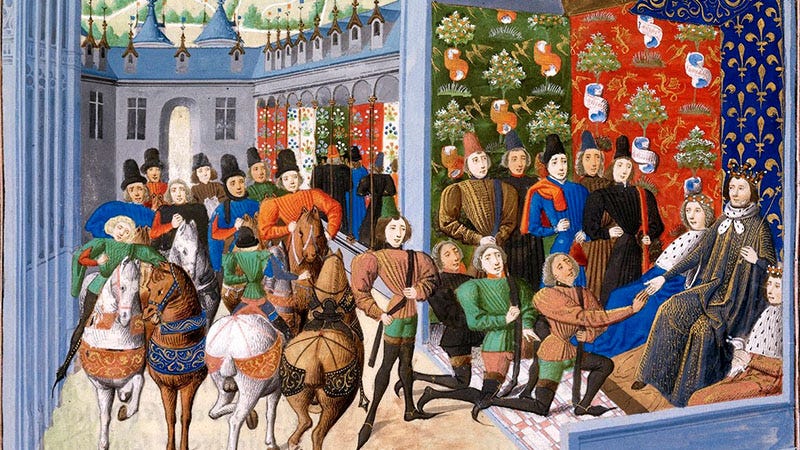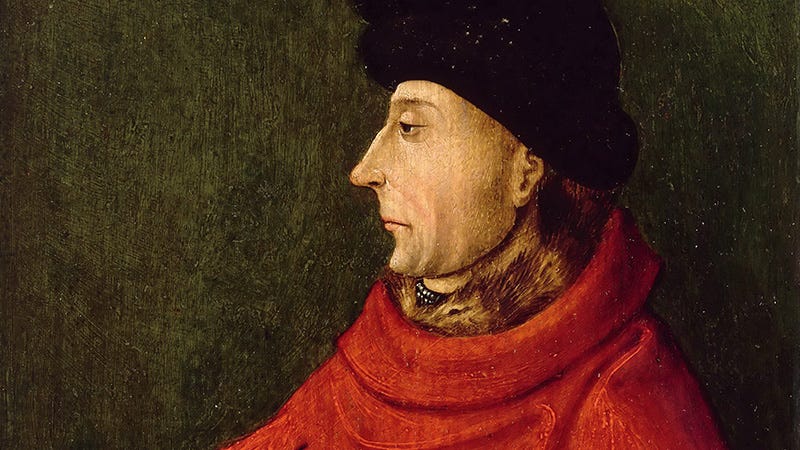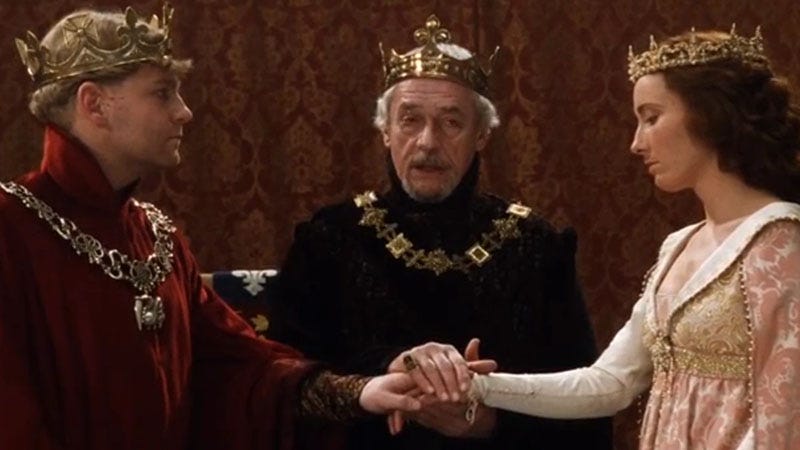Charles VI went from being known as the ‘well beloved’ to losing his mind - quite literally overnight. Paralysed by his mental health, traumatised by the terrifying Bal des Ardents, and convinced he was made of glass, Charles was unable to rule. A power vacuum emerged, one which threatened to destroy the entire kingdom and hand it to the enemy. Read Part 1 here!
The reign of Charles VI of France didn’t so much fall apart as it slowly disintegrated - unravelling in a long, painful spiral of madness, power struggles, and bloodshed. As the king descended into mental illness, the person left to pick up the pieces was his queen, Isabeau of Bavaria. Thrust into an unwinnable position, Isabeau had to rule a fractured realm. France, already staggering under the weight of the Hundred Years’ War, was now facing internal collapse. A feud between two powerful noble factions turned into a national crisis, feeding chaos, betrayal, and murder, all while England hovered over the weakened kingdom like a vulture waiting to strike.
The Armagnacs vs the Burgundians
At the heart of this struggle were the Armagnacs, loyal to the royal family, and the Burgundians, led by the powerful Dukes of Burgundy, who sought to control the French crown for their own gain. Two dominant figures emerged: Louis, Duke of Orleans, the king's brother, and the fantastically named John the Fearless, Duke of Burgundy, the king’s cousin. Their rivalry, which had begun as a struggle for influence over the crown, quickly spiraled into open warfare.
Louis was young, ambitious, and suspected to be Isabeau’s lover, even the real father of her children, giving him enormous influence at court. He spent lavishly and surrounded himself with poets and intellectuals, making him the face of the highly cultured but corrupt royal circle. John the Fearless, by contrast, was a cold, calculating strategist, far more interested in raw political power than courtly pleasures. He was the son of Philip the Bold, Duke of Burgundy, whose lands in the east of France were nearly as wealthy as the French crown itself. John saw Louis as his greatest rival, an obstacle to Burgundian dominance over France.
Louis may have wielded considerable influence but the rumours of his affair with the queen and his reputation as a womaniser in general meant he was deeply unpopular. His role in the Bal des Ardents definitely didn’t help. The public much preferred John the Fearless over the flamboyant Louis, as he represented the urban and mercantile interests of northern France and advocated for reform and reduced taxation.
In 1407 this rivalry exploded into outright murder. As Louis returned from visiting the queen, he was ambushed in the streets of Paris and hacked to death by assassins. His hand was reportedly severed as he tried to shield himself and his skull was split by an axe. At the risk of stating the obvious, the mastermind behind this bloody deed was none other than John the Fearless. John didn’t even try to deny it. In fact, he wrote about it in an article advocating tyrannicide, justifying the murder as a patriotic act which removed a corrupt and dangerous prince.
It was a bold gamble but Charles VI was too ill, and Isabeau too politically isolated, to take revenge. And so began one of the darkest chapters in French history: the Armagnac–Burgundian Civil War. Louis’s son was still a child so the torch of vengeance was picked up by his father-in-law, Bernard of Armagnac. Under his leadership, the Armagnacs - loyal to the royal family - began a campaign to restore their honour and retaliate against the populist Burgundians. France was soon cleaved in two: the Armagnacs in the south and center, the Burgundians in the north. Both sides claimed legitimacy. Both sides raised armies. And both committed atrocities in the name of justice and reform.
England makes its move
As civil war raged, England saw its chance. It had always been there in the background, gleefully watching the chaos unfolding in France. In fact, the Burgundians allied with the English, further exacerbating the crisis. In 1415, Henry V invaded France, delivering a devastating defeat at the Battle of Agincourt, partially aided by the Burgundians choosing to remain neutral… Thousands of French knights were slaughtered, and the country was now at its weakest. In 1418, the Burgundians seized Paris in a bloody coup. The Armagnac leader, Bernard, was captured and murdered.
The devastation at Agincourt made it clear that the civil war had to end if France had any hope of fighting back. In 1419, the young Dauphin Charles, who was aligned with the Armagnacs, agreed to meet John the Fearless for peace talks.
It was a trap.
A special enclosure had been constructed on a bridge, where John and the Dauphin could meet in relative privacy, along with an entourage of just ten men each. John reportedly had a bad feeling about the meeting and this turned out to be entirely justified when the Dauphin’s men suddenly planted an axe in his face. Turns out the young Charles wasn’t ready to forgive the murder of his uncle Louis….
The consequences were catastrophic. Instead of setting aside personal animosity for the good of the kingdom, the royal family chose violence. Philip the Good, John’s son and successor, swore vengeance. He abandoned any hope of unity with the royal family and fully allied with England. The Burgundians handed Paris over to the English, allowing Henry V to march triumphantly into the city. But that was only the beginning of the betrayal. Philip’s actions paved the way for the infamous Treaty of Troyes.
The ultimate betrayal
Charles VI was still incapable of ruling and the French aristocracy had tried to take advantage of this. Now, it was the turn of the English. Burgundy had long operated semi-independently of the French crown and its economic interests aligned with England. Closer ties with England offered military support and the potential for greater autonomy. Both parties would benefit enormously if Henry V ruled France instead of the Dauphin Charles, whose reputation had taken a battering following the murder of John the Fearless and the rumours of his mother’s affair with Louis of Orleans.
Through months of negotiation - with Queen Isabeau of Bavaria acting as a key intermediary - Henry pursued not merely land or tribute, but the French crown itself. Isabeau, disillusioned with her son and furious over the killing of John the Fearless, lent her support to the English cause. Whether out of political calculation, desperation, or resentment, she participated in the most shocking diplomatic act of her era. The result was the Treaty of Troyes, signed in May 1420. This treaty was a reimagining of dynastic succession, one that severed the natural line of inheritance and delivered France into the hands of its old enemy.
By its terms, Henry V was recognised as the legitimate heir to Charles VI. The Dauphin, still very much alive and actively resisting in the south, was declared illegitimate and unfit to inherit. To cement the arrangement, Henry married Catherine of Valois, the daughter of Charles and Isabeau, creating a dynastic union intended to bind the two crowns into one empire.
Why would Isabeau betray her country and disinherit her own son in this way? Perhaps she believed he was unfit to rule, either because of his role in past crimes or his inability to consolidate support. Perhaps she feared what would happen if the kingdom fell into the hands of a young, divisive prince. Or perhaps, like many others at court, she recognised that Henry V, for all his foreignness, offered a future of structure and strength, while her son seemed to offer only more civil war.
The English had finally achieved legal recognition of their claim to the French throne, confirmed by marriage, approved by the king, and ratified by the Estates-General. The Hundred Years War was over in all but name and the English could sit back and revel in their victory.
Fate had other plans, however.
The Treaty of Troyes depended entirely on the survival of Henry V. Only two years after the treaty’s signing, Henry died of illness at the age of 35. Charles VI followed him to the grave soon after. What remained was an infant: Henry VI, nine months old, declared King of England and France. Charles VII, the disinherited Dauphin, declared his own kingship. To many Frenchmen, especially those untouched by the English alliance or opposed to Burgundian influence, he remained the rightful king.
The English found themselves embroiled in a prolonged war once again and their occupation was increasingly viewed not as legitimate governance, but as foreign domination. And the young Dauphin was about to meet someone who would change the course of the war - and French history - forever: a peasant girl named Joan of Arc.
But that is another story.







